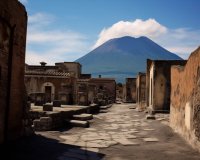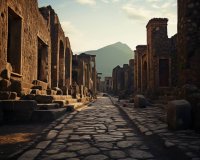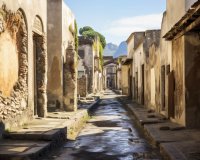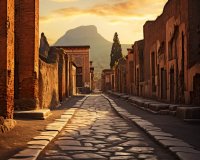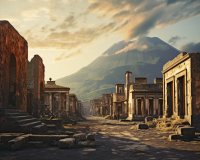Ancient Echoes: Exploring the Ruins of Pompeii and Naples

Ancient Echoes: Exploring the Ruins of Pompeii and Naples
Welcome to the mesmerizing world of ancient history and archaeology as we embark on a journey to explore the ruins of Pompeii and Naples. These two Italian cities, nestled in the shadow of Mount Vesuvius, hold the keys to a time long past, where the ancient Romans thrived and ultimately met their doom.
The city of Pompeii, once a bustling Roman settlement, was buried under layers of volcanic ash and pumice when Mount Vesuvius erupted in 79 AD. For centuries, it remained forgotten until its rediscovery in the 18th century. Today, Pompeii is a UNESCO World Heritage Site and offers a unique window into Roman life during the 1st century AD.
The Tragic Tale of Pompeii
The story of Pompeii is both awe-inspiring and tragic. The eruption of Mount Vesuvius, which destroyed the city, also preserved it. As you walk through the cobbled streets, you'll encounter remarkably preserved buildings, frescoes, mosaics, and even the haunting plaster casts of the city's residents, forever frozen in their final moments of agony.
One of the most remarkable aspects of Pompeii is its state of preservation. You can stroll through the ruins of Roman houses, public baths, theaters, and even a brothel, all offering a glimpse into the daily life, culture, and architecture of ancient Rome. The Forum, the city's political and economic heart, is a must-see, where you can still see the grandeur of the ancient Roman civilization.
Naples: Gateway to Pompeii
While Pompeii captures much of the attention, the nearby city of Naples plays a crucial role as the gateway to this ancient wonder. Naples, a vibrant and chaotic city, offers a rich cultural experience in its own right. It's famous for its Neapolitan pizza, bustling markets, and historic districts.
Before you make your way to Pompeii, take some time to explore Naples. Visit the Naples National Archaeological Museum, which houses an impressive collection of artifacts and artwork from Pompeii and Herculaneum. The museum provides a fantastic introduction to what you'll witness in the ancient ruins.
Exploring Pompeii
When you arrive in Pompeii, prepare to be transported back in time. The city layout, complete with its streets, houses, temples, and even an amphitheater, is remarkably well-preserved. The once-vibrant frescoes that adorned the walls of these ancient buildings now provide a vivid glimpse into Roman aesthetics and daily life.
As you wander through the ruins, don't miss the House of the Faun, a grand residence that boasts an exquisite mosaic of a dancing faun. The Villa of the Mysteries is another must-see, known for its enigmatic frescoes that depict a mysterious initiation rite.
A Living History Lesson
Exploring Pompeii and Naples is like taking a step into history's classroom. The site offers a wealth of information about ancient Roman society, including their architecture, art, and everyday customs. It's a place where history comes to life, and you can almost hear the echoes of conversations in the ancient Forum or the applause in the amphitheater.
So, if you're a history enthusiast, an archaeology buff, or simply someone who appreciates the beauty of the past, the ruins of Pompeii and the city of Naples are a must-visit destination. These ancient echoes will forever leave an indelible mark on your memory, reminding you of the splendor and fragility of human civilization.
Plan your trip to Pompeii and Naples today and embark on a journey through time that will leave you with lasting memories and a deep appreciation for the wonders of our ancient world.
Discover Pompeii, Herculaneum, and Vesuvius
Embark on a full-day tour exploring the historical marvels shaped by the infamous eruption of Vesuvius in 79 AD.
About this Activity
Experience a "full immersion" in history with visits to Pompeii and Herculaneum, two UNESCO World Heritage Sites. Delve into the natural beauty of Vesuvius and its stunning park, marveling at the preserved characteristics, paintings, and architecture that bear witness to Roman times.
Highlights
- Visit three sites in one day
- Explore the History of Vesuvius Eruption of 79 A.D.
- Enjoy a comfortable transfer and stress-free tour
What's Included
- Direct transfer to Vesuvius in a deluxe minibus
- Free time to explore the Great Cone of Vesuvius
- Transfers to the entrances of Herculaneum and Pompeii excavations
- Audio guide and detailed map for independent Pompeii visit
- Parking, Ztl, Tolls, and Fuel
- Skip the Line Entrance Tickets for Pompeii, Herculaneum, Vesuvius
Not Included
Foods and beverages
Important Information
- Check availability for your preferred language
- Meeting point: Open in Google Maps
What to Bring
- Passport or ID card
- Comfortable shoes and clothes
- Hat
- No luggage or large bags allowed
Know Before You Go
To rent the audioguide for Pompeii Ruins, a Valid ID document is essential.
From $126.02 per person
Reserve now & pay later to secure your spot without any upfront payment.
Customer Reviews
Overall rating: 5/5 based on 1 review
Review: "Incredible, 100% recommended, climbing the volcano, walking through Herculiano and Pompeii, we lacked time but this day was worth all the physical and economic effort, thank you all, we are very happy." - Araceli, Mexico
Date of visit: September 16, 2023
Delving into History: The Mysteries of Pompeii
Pompeii, a city frozen in time, is one of the most iconic archaeological sites in the world. The story of Pompeii is a fascinating one, filled with mystery, tragedy, and the resilience of human history. In this article, we will delve into the secrets and wonders of this ancient Roman city.
Located in southern Italy, near the modern city of Naples, Pompeii was a thriving Roman city until it met its catastrophic end in 79 AD. The eruption of Mount Vesuvius buried the city under layers of ash and pumice, preserving it for nearly 2,000 years. When the city was rediscovered in the 18th century, it provided historians and archaeologists with a unique window into the daily life of the ancient Romans.
The City of Pompeii
Pompeii was a bustling city with a population of approximately 20,000 people at the time of its destruction. It was known for its vibrant culture, impressive architecture, and a thriving economy. The city boasted theaters, bathhouses, villas, and an amphitheater that could hold up to 20,000 spectators. Pompeii was a testament to the advancement of Roman civilization in the first century AD.
The Eruption of Mount Vesuvius
The eruption of Mount Vesuvius in 79 AD was a cataclysmic event that forever altered the course of Pompeii's history. The volcanic explosion sent a plume of ash, rock, and gas miles into the air, blotting out the sun and causing panic among the city's residents. The initial phase of the eruption led to the deposition of ash and pumice, which blanketed Pompeii and preserved it in a state of suspended animation.
One of the most haunting aspects of the eruption was the pyroclastic surge, a fast-moving cloud of hot gas and volcanic matter that descended upon the city. It is estimated that this surge reached temperatures of up to 900 degrees Celsius (1,650 degrees Fahrenheit), instantly killing anyone it touched. As a result, many of the city's inhabitants were encased in the ash, leaving behind voids that archaeologists would later fill with plaster to reveal the shapes of the deceased.
Archaeological Discoveries
The excavation of Pompeii began in the 18th century, and it continues to this day. The city's well-preserved state has provided a wealth of knowledge about ancient Roman life. Archaeologists have uncovered homes, frescoes, pottery, jewelry, and even preserved food items, shedding light on the daily activities and customs of the people who once lived there.
Perhaps the most famous discovery in Pompeii is the "Villa of the Mysteries." This villa, adorned with intricate frescoes, is believed to have been a place of initiation for a mysterious cult. The exact nature of the cult remains a subject of debate among scholars, adding to the enigmatic aura of Pompeii.
The People of Pompeii
One of the most moving aspects of Pompeii's story is the human element. The plaster casts of victims, frozen in their final moments, offer a poignant glimpse into the human tragedy that unfolded during the eruption. These casts capture the expressions of fear, anguish, and even resignation on the faces of the inhabitants as they met their untimely end. It's a stark reminder of the impermanence of life and the power of nature.
The Ongoing Mysteries
Despite centuries of exploration and research, Pompeii still holds many mysteries. Archaeologists and historians continue to uncover new details about the city and its inhabitants. Some of the enduring questions include the exact nature of the religious practices at the Villa of the Mysteries, the daily lives of the people, and the extent of trade and cultural exchange in Pompeii.
In recent years, modern technology has been employed to further study Pompeii. Advanced imaging techniques, including laser scanning and DNA analysis, have provided new insights into the city's history and its people.
Preservation and Tourism
Pompeii is a UNESCO World Heritage Site, and efforts are ongoing to preserve and protect this extraordinary site for future generations. While tourism brings much-needed attention and funding, it also poses a challenge in terms of conservation. The delicate balance between allowing public access and safeguarding the ancient city's integrity remains an ongoing concern.
Visitors to Pompeii today can walk through the well-preserved streets, visit ancient shops, and witness the incredible art and architecture that have endured for millennia. It's a journey back in time that few places on Earth can offer.
Conclusion
Pompeii, with its tragic history and remarkable preservation, continues to captivate the world. It stands as a testament to the power of nature and the enduring spirit of human civilization. The mysteries of Pompeii are far from being fully unraveled, and it will remain a source of fascination and inspiration for generations to come.
Full Day Tour of Pompeii, Herculaneum, and Vesuvius from Naples
Explore the fascinating history of Pompeii and Herculaneum, and witness the awe-inspiring Vesuvius eruption of 79 A.D. during this full-day tour. Your adventure begins with convenient pick-up and drop-off in Naples.
During this activity, enjoy the flexibility of free cancellation up to 24 hours in advance for a full refund. You can reserve your spot today and pay later. Additionally, the tour operator has implemented special health and safety measures to ensure a safe experience.
Duration: 8.5 hours
Highlights
Embark on a journey to three remarkable sites in a single day:
- Explore the history of the Vesuvius eruption of 79 A.D.
- Enjoy a comfortable tour directly from Naples.
Live the experience of a "full immersion" in the history and places that made the eruption of Vesuvius famous in 79 AD. Spend an entire day visiting the two renowned archaeological sites, Pompeii and Herculaneum, and the volcano itself, which completely destroyed them in Roman times but left their characteristics, paintings, and architecture intact. This tour is designed for those who wish to explore these precious UNESCO World Heritage Sites autonomously, without the stress of long waiting lines.
Includes:
- Pick up in Naples (Hotel Ramada)
- Direct transfer in deluxe minibus to reach Vesuvius
- Free time to visit the Great Cone of Vesuvius
- Direct transfer by deluxe minibus to reach the entrance to the excavations of Herculaneum
- Direct transfer by deluxe minibus to reach the entrance to the Pompeii excavations
- Illustration of the itineraries and assistance from our staff before entering the Pompeii excavations
- Audio guide and detailed map for the independent visit of Pompeii
- Parking
- ZtlTolls and Fuel
- Skip the Line Entrance Tickets (Pompeii, Herculaneum, Vesuvius)
Not Included: Food and beverages
Not Suitable for: People with mobility impairments
Available Languages
This tour offers commentary in various languages:
- Italian
- English
- Chinese
- French
- German
- Hebrew
- Portuguese
- Russian
- Spanish
Meeting Point: Open in Google Maps ⟶
Important Information
What to Bring: Passport or ID card
Not Allowed: Luggage or large bags
Know Before You Go: It's essential to bring a valid ID document to rent the Audioguide for Pompeii Ruins. Audioguides are only available for Pompeii site.
Reserve your spot today and pay nothing now. You can also choose to gift this experience to someone special.
Living History: Art and Culture of Ancient Naples Pompeii
Naples, a city that stands as a living testament to the art and culture of ancient Pompeii, is a place steeped in history and beauty. The city itself is a masterpiece, but it is in the shadows of Mount Vesuvius that the true wonders of the past come to life. In this article, we will embark on a journey through time to explore the art and culture of ancient Naples and Pompeii.
When we think of Pompeii, our minds often conjure images of a city frozen in time, buried beneath layers of volcanic ash. This is not far from the truth. In 79 AD, the eruption of Mount Vesuvius buried the Roman city of Pompeii under layers of ash and pumice, preserving it in remarkable detail. The archaeological excavations that began in the 18th century have uncovered an incredible wealth of art and artifacts.
One of the most iconic features of Pompeii is its well-preserved frescoes. These paintings adorned the walls of villas and public buildings, and they provide a vivid insight into the aesthetics and daily life of the ancient Romans. The frescoes depict scenes of mythology, nature, and daily routines, showcasing the artistic prowess of the time. From the vibrant colors to the intricate details, these frescoes are a true marvel of ancient art.
Another remarkable aspect of Pompeii's culture is its architecture. The city boasts well-designed buildings with beautiful mosaics, intricate courtyards, and public spaces. The Roman influence on architecture is evident, and Pompeii showcases the ingenuity of the time in constructing structures that still captivate visitors today. From the grand amphitheater to the well-preserved temples, every stone speaks of a civilization that valued both functionality and aesthetics.
But Pompeii was not just a place of art and architecture; it was a bustling city with a thriving culture. The ruins include markets, bakeries, and brothels, giving us a glimpse into the daily life of its inhabitants. The streets are paved with large stone blocks, and you can still see the ruts created by the wheels of chariots. The city was remarkably well-planned, with an advanced sewage system and public baths that reflected the Roman love for communal living.
One of the most famous and poignant aspects of Pompeii is its tragic end. The plaster casts of victims, made by pouring liquid plaster into the voids left by decomposed bodies, offer a haunting reminder of the human toll of the eruption. These casts bring a sense of humanity to the archaeological site, making it more than just a historical artifact but a place of remembrance and reflection.
Modern-Day Naples: A Living Legacy
While the ancient city of Pompeii was buried and forgotten for centuries, Naples has continued to thrive and evolve. Today, Naples is a vibrant and bustling city, where the echoes of its past can be seen, heard, and tasted. The art and culture of ancient Naples Pompeii are not confined to archaeological sites but have become an integral part of the city's identity.
The Naples National Archaeological Museum is a treasure trove of artifacts from Pompeii and the surrounding area. Here, you can find an extensive collection of sculptures, frescoes, and everyday objects that provide a deeper understanding of life in Pompeii. The Farnese Bull, a massive marble sculpture, and the stunning mosaic of the Battle of Alexander are among the museum's highlights.
Naples is also known for its culinary traditions, which have deep roots in ancient Roman culture. The city is famous for its pizza, and it's said that the Margherita pizza was created in Naples as a tribute to Queen Margherita of Savoy. The flavors and ingredients used in Neapolitan cuisine harken back to the ancient world, connecting modern food culture with that of the past.
As you wander through the streets of Naples, you'll encounter various churches and chapels, many of which house exquisite works of art. The Naples Cathedral, dedicated to the city's patron saint, San Gennaro, is a prime example. Its baroque architecture and grand artwork are a testament to the enduring influence of religion and art in the city.
In conclusion, Naples, with its deep historical roots and connection to ancient Pompeii, is a living history book. The art and culture of this region are not confined to the pages of the past but continue to shape the city's identity and offerings today. Visiting Naples is like stepping into a time machine that allows you to explore the art, culture, and daily life of ancient Pompeii while enjoying the modern amenities and rich traditions of this vibrant Italian city.


